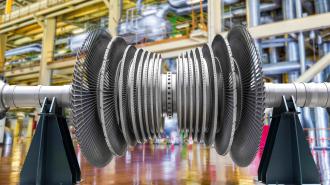A new high-performance metal alloy, called a superalloy, could help boost the efficiency of the turbines used in power plants and the aerospace and automotive industries.
Created using a 3D printer, the superalloy is composed of a blend of six elements that altogether form a material that’s both lighter and stronger than the standard materials used in conventional turbine machinery. The strong superalloy could help industries cut both costs and carbon emissions — if the approach can be successfully scaled up.
The challenge: In the world of materials science, the search for new metal alloys has been heating up in recent years. For over a century, we’ve depended on relatively simple alloys like steel, composed of 98% iron, to form the backbone of our manufacturing and construction industries. But today’s challenges demand more: alloys that can withstand higher temperatures and remain strong under stress, yet still be lightweight.
Engineers have long tried to optimize the materials used in turbines — the spinning machinery in power plants that help convert mechanical energy into electricity. But even state-of-the-art materials, like nickel- and cobalt-based superalloys, tend to degrade and perform worse when exposed to extremely high temperatures.
That’s one reason why scientists have spent the past two decades experimenting with complex alloys, some consisting of up to six different metals. By tweaking the exact proportions of elements that make up a superalloy, scientists hope that new atomic-scale interactions will occur, leading to the discovery of beneficial properties. However, with an almost infinite combination of elements in different proportions, optimizing these alloys for specific applications presents a significant challenge.
The innovation: One promising approach is the use of 3D printing technology. This method allows researchers to control the relative proportions of different metals precisely. They achieve this by rapidly melting metals in a solid, powdered form using a powerful laser and then depositing them in thin layers.
A team of researchers led by Andrew Kustas at Sandia National Laboratories, Albuquerque, New Mexico, utilized this technique to develop a high-performing six-element superalloy. The alloy — made of 42% aluminum, 25% titanium, 13% niobium, 8% zirconium, 8% molybdenum, and 4% tantalum — is strong, lightweight, and incredibly heat resistant.
These characteristics are especially important for the turbines used in power plants, which account for approximately 73% of all electricity generation worldwide. After all, the higher the temperature of the gas driving the turbines, the faster they spin and the more efficient they become.
When heated to 800°C (1472°F) — a common temperature in power plant turbines — this superalloy remained stronger and more lightweight than many others designed for a similar purpose. This breakthrough suggests potential applications beyond power turbines, particularly in aerospace where materials need to be strong, lightweight, and resistant to extreme temperature variations.
The researchers also found that the performance of the superalloy correlated with predictions generated from a computer model that was designed to predict how particular combinations of elements would conduct thermal energy. Those predictions suggest that future computer models might be able to help predict which combinations of elements are likely to result in new and useful superalloys.
To bring the recently created superalloy into mainstream manufacturing, the team hopes to find a way to economically scale up their 3D printing process while ensuring that the finished products don’t contain micro-scale cracks, which may prove difficult to do on a larger scale. Surmounting these challenges could help make the machines that power our everyday lives both stronger, more efficient, and less damaging to the environment.






